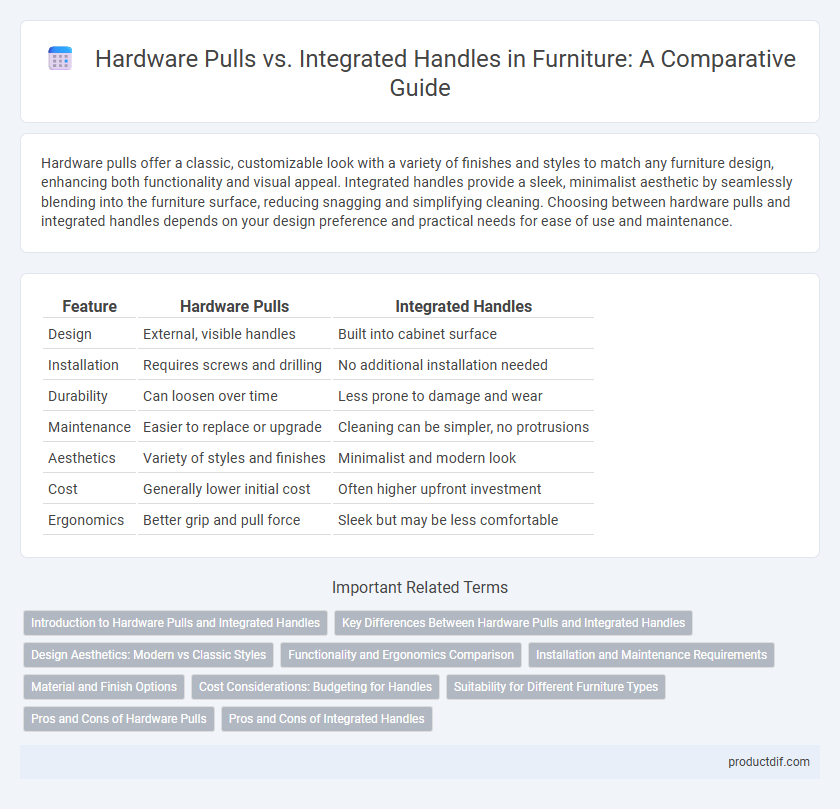Hardware pulls offer a classic, customizable look with a variety of finishes and styles to match any furniture design, enhancing both functionality and visual appeal. Integrated handles provide a sleek, minimalist aesthetic by seamlessly blending into the furniture surface, reducing snagging and simplifying cleaning. Choosing between hardware pulls and integrated handles depends on your design preference and practical needs for ease of use and maintenance.
Table of Comparison
| Feature | Hardware Pulls | Integrated Handles |
|---|---|---|
| Design | External, visible handles | Built into cabinet surface |
| Installation | Requires screws and drilling | No additional installation needed |
| Durability | Can loosen over time | Less prone to damage and wear |
| Maintenance | Easier to replace or upgrade | Cleaning can be simpler, no protrusions |
| Aesthetics | Variety of styles and finishes | Minimalist and modern look |
| Cost | Generally lower initial cost | Often higher upfront investment |
| Ergonomics | Better grip and pull force | Sleek but may be less comfortable |
Introduction to Hardware Pulls and Integrated Handles
Hardware pulls are traditional furniture components made from metal, plastic, or wood, designed for easy gripping and opening of drawers or cabinets. Integrated handles are built directly into the furniture surface, offering a sleek, minimalist look while maintaining functionality. Choosing between hardware pulls and integrated handles depends on style preferences, ease of use, and design requirements.
Key Differences Between Hardware Pulls and Integrated Handles
Hardware pulls offer versatile designs and easy replaceability, allowing for customization and upgrades in furniture aesthetics, while integrated handles provide a sleek, minimalist look by being built into the furniture surface, enhancing seamless design and reducing protrusions. Hardware pulls require installation and may add visual texture or contrast, whereas integrated handles maintain a smooth finish and are often favored in modern, space-saving designs. Durability considerations differ as hardware pulls can be swapped if damaged, but integrated handles, being part of the structure, typically require more complex repairs or replacements.
Design Aesthetics: Modern vs Classic Styles
Hardware pulls offer a classic design aesthetic with varied finishes and shapes that complement traditional and transitional furniture styles, adding distinct visual interest and tactile appeal. Integrated handles align with modern, minimalist design trends by providing a sleek, seamless look that emphasizes clean lines and simplicity. Choosing between hardware pulls and integrated handles depends on the desired style outcome, with pulls enhancing timeless elegance and integrated designs supporting contemporary sophistication.
Functionality and Ergonomics Comparison
Hardware pulls offer versatile grip options and enhanced leverage, making them suitable for various hand sizes and providing ease of use in heavy drawers or cabinets. Integrated handles create a sleek, minimalist aesthetic that reduces snag points and ensures a smooth surface, improving safety in tight spaces and promoting ergonomic finger placement. Choosing between hardware pulls and integrated handles depends on the priority of tactile comfort, ease of operation, and overall design cohesion in furniture use.
Installation and Maintenance Requirements
Hardware pulls require precise drilling and alignment during installation to ensure secure attachment and proper function, while integrated handles offer a streamlined approach with minimal installation effort, often built into the furniture during manufacturing. Maintenance for hardware pulls involves regular cleaning around the mounts and occasional tightening of screws to prevent loosening, whereas integrated handles demand less upkeep due to their seamless design, reducing the risk of dirt accumulation and mechanical failure. Both options impact long-term durability and user convenience, with hardware pulls offering easy replaceability and integrated handles providing a sleek, low-maintenance solution.
Material and Finish Options
Hardware pulls offer a wide range of material options including brass, stainless steel, zinc alloy, and aluminum, allowing for finishes such as polished chrome, matte black, brushed nickel, and antique bronze, which enhance durability and aesthetic appeal. Integrated handles are typically made from the same material as the furniture, such as wood, MDF, or metal, with finishes that match or complement the surrounding surfaces, providing a sleek and seamless look. Choosing between hardware pulls and integrated handles depends on desired customization flexibility, maintenance preferences, and overall design coherence.
Cost Considerations: Budgeting for Handles
Hardware pulls generally require a higher upfront cost due to individual purchase and installation expenses, whereas integrated handles offer cost savings by eliminating separate hardware needs and reducing labor time. Budgeting for handles should factor in material quality, brand reputation, and long-term durability to avoid frequent replacements. Selecting integrated handles can lead to streamlined costs in modern furniture designs while hardware pulls remain a flexible option for diverse aesthetic preferences.
Suitability for Different Furniture Types
Hardware pulls offer versatile suitability for various furniture types, especially traditional cabinetry, dressers, and desks, providing easy grip and decorative appeal. Integrated handles are ideal for modern and minimalist furniture designs, such as contemporary kitchen cabinets and sleek office desks, ensuring a seamless and clean aesthetic. The choice between hardware pulls and integrated handles depends on the functional requirements and stylistic coherence of the furniture piece.
Pros and Cons of Hardware Pulls
Hardware pulls offer a classic aesthetic and are available in a wide range of styles and finishes, enhancing the customization of furniture pieces. They provide a secure grip and ease of installation or replacement, but can accumulate dirt and require maintenance compared to integrated handles. However, protruding hardware pulls may catch on clothing or impede smooth surface cleaning in some furniture designs.
Pros and Cons of Integrated Handles
Integrated handles in furniture offer a sleek, minimalist design that enhances seamless aesthetics and reduces visual clutter. These handles are easier to clean and prevent snagging or accidental damage, making them ideal for modern, high-traffic spaces. However, integrated handles may lack the ergonomic comfort and tactile feedback of hardware pulls, potentially making drawers and cabinets harder to open, especially for individuals with limited hand strength.
Hardware Pulls vs Integrated Handles Infographic

 productdif.com
productdif.com